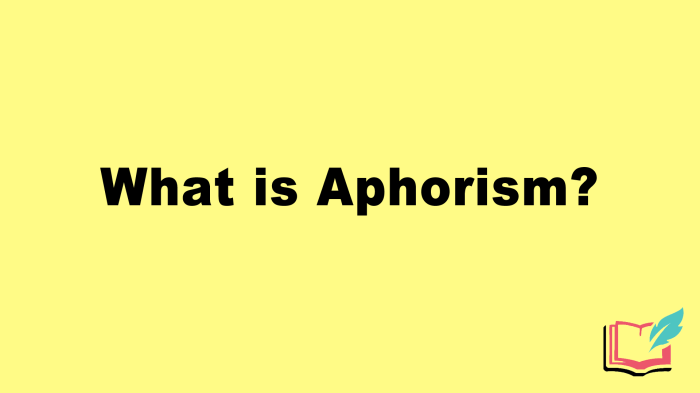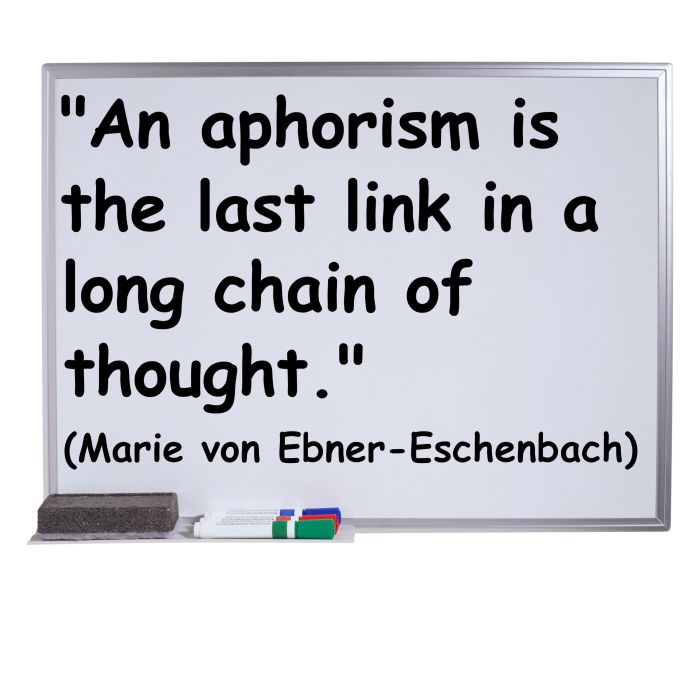An aphorism is a cleverly worded statement that conveys a truth or insight in a concise and memorable way. Aphorisms have been used for centuries to communicate wisdom, wit, and guidance, and they continue to be a valuable tool for expressing complex ideas in a simple and impactful manner.
The key elements of an effective aphorism include brevity, clarity, and cleverness. Aphorisms are typically short, often consisting of only a few words or phrases. This brevity allows them to be easily remembered and shared. Clarity is also essential, as aphorisms should be easy to understand and interpret.
Finally, cleverness is what sets aphorisms apart from ordinary statements. Aphorisms often use wordplay, irony, or other literary devices to create a memorable and thought-provoking statement.
Defining Aphorisms
An aphorism is a concise, cleverly worded statement that encapsulates a general truth or principle. Aphorisms are often witty, thought-provoking, and easy to remember, making them effective tools for conveying wisdom and insight.
Aphorisms differ from proverbs in that they are typically more focused on general truths rather than specific situations. They are also more likely to be attributed to a particular author, while proverbs are often passed down through generations without a known source.
Purpose and Significance of Aphorisms
- Convey wisdom and insight in a concise and memorable way
- Provide guidance and direction
- Inspire and motivate
- Challenge and provoke thought
- Enrich language and communication
Elements of an Aphorism

Key Elements
- Conciseness: Aphorisms are typically short and to the point, often consisting of a single sentence.
- Wit: Aphorisms often employ humor or clever wording to make their point more memorable.
- Truth: Aphorisms express general truths or principles that are widely applicable.
- Universality: Aphorisms are not tied to a specific time or place, making them relevant to people from all backgrounds.
Examples of Effective Aphorisms
- “All that glitters is not gold.” – William Shakespeare
- “The early bird catches the worm.” – Proverb
- “Ignorance is bliss.” – Thomas Gray
Examples of Ineffective Aphorisms
- “The sun rises in the east.” – This is a factual statement, not an aphorism.
- “Don’t judge a book by its cover.” – This is a common proverb, not an original aphorism.
- “Life is too short to worry about the small things.” – This is a vague and overused statement.
Techniques for Crafting Aphorisms

Brainstorming
Start by brainstorming a list of topics or themes that you are interested in. Once you have a list of topics, freewrite about each topic, allowing your thoughts to flow freely.
Conciseness
Keep your aphorisms short and to the point. The more concise your aphorism, the more likely it is to be remembered.
Wit
Use humor or clever wording to make your aphorism more memorable. However, avoid being too obvious or corny.
Truth
Make sure that your aphorism expresses a general truth or principle. The more true your aphorism is, the more likely it is to resonate with people.
Universality, An aphorism is a cleverly worded statement
Try to write aphorisms that are not tied to a specific time or place. The more universal your aphorism, the more likely it is to be relevant to people from all backgrounds.
Applications of Aphorisms

Literature
Aphorisms are often used in literature to provide insight into the characters or to comment on the human condition. For example, Shakespeare’s plays are full of aphorisms, such as “To be or not to be, that is the question.”
Speeches
Aphorisms can be used in speeches to make a point more memorable or to inspire the audience. For example, Martin Luther King Jr.’s “I have a dream” speech is full of aphorisms, such as “We shall overcome.”
Everyday Conversation
Aphorisms can also be used in everyday conversation to add wit or wisdom to a discussion. For example, you might say “The early bird catches the worm” to encourage someone to be punctual.
Cultural and Historical Context of Aphorisms: An Aphorism Is A Cleverly Worded Statement

Cultural Significance
Aphorisms are often used to express the values and beliefs of a particular culture. For example, the Chinese proverb “The nail that sticks out gets hammered down” reflects the Chinese value of humility.
Historical Significance
Aphorisms can also provide insight into the history of a particular culture. For example, the Greek aphorism “Know thyself” was inscribed on the Temple of Apollo at Delphi and reflects the Greek emphasis on self-knowledge.
FAQ Overview
What is an aphorism?
An aphorism is a cleverly worded statement that conveys a truth or insight in a concise and memorable way.
What are the key elements of an effective aphorism?
The key elements of an effective aphorism include brevity, clarity, and cleverness.
How can aphorisms be used?
Aphorisms can be used to teach, inspire, entertain, challenge our assumptions, and help us see the world in a new way.